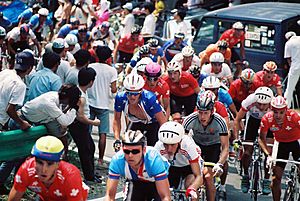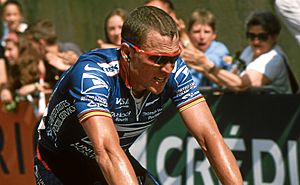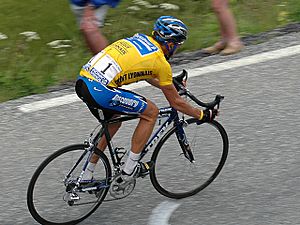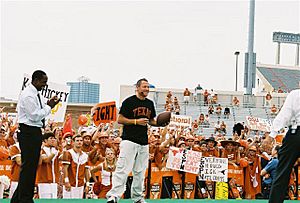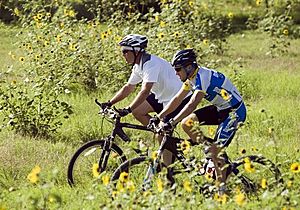Lance Armstrong facts for kids
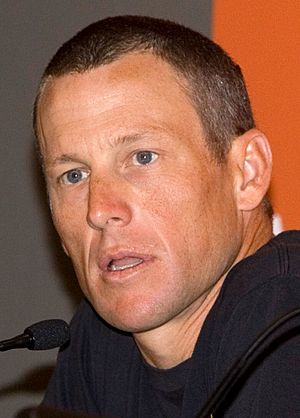
Armstrong before the 2009 Tour Down Under
|
|||
| Personal information | |||
|---|---|---|---|
| Full name | Lance Edward Armstrong | ||
| Nickname | Le Boss Big Tex |
||
| Born | September 18, 1971 Richardson, Texas, U.S. |
||
| Height | 1.77 m (5 ft 9+1⁄2 in) | ||
| Weight | 75 kg (165 lb) | ||
| Team information | |||
| Discipline | Road | ||
| Role | Rider | ||
| Rider type | All-rounder | ||
| Major wins | |||
|
|||
Lance Edward Armstrong (né Gunderson; born September 18, 1971) is an American former professional road racing cyclist. He achieved international fame for winning the Tour de France a record seven consecutive times from 1999 to 2005, but was stripped of his titles. He is currently banned for life from all sanctioned bicycling events.
At age 16, Armstrong began competing as a triathlete and was a national sprint-course triathlon champion in 1989 and 1990. In 1992, he began his career as a professional cyclist with the Motorola team. He had success between 1993 and 1996 with the World Championship in 1993, the Clásica de San Sebastián in 1995, Tour DuPont in 1995 and 1996, and a handful of stage victories in Europe, including stage 8 of the 1993 Tour de France and stage 18 of the 1995 Tour de France. In 1996, he was diagnosed with a potentially fatal metastatic testicular cancer. After his recovery, he founded the Lance Armstrong Foundation (now the Livestrong Foundation) to assist other cancer survivors.
Returning to cycling in 1998, Armstrong was a member of the US Postal/Discovery team between 1998 and 2005 when he won his seven Tour de France titles. Armstrong retired from racing at the end of the 2005 Tour de France, but returned to competitive cycling with the Astana team in January 2009, finishing third in the 2009 Tour de France later that year. Between 2010 and 2011, he raced with Team Radio Shack, and retired for a second time in 2011.
Armstrong received a lifetime ban from all sports that follow the World Anti-Doping Code, ending his competitive cycling career. The International Cycling Union (UCI) upheld USADA's decision and decided that his stripped wins would not be allocated to other riders.
Early life
Armstrong was born Lance Edward Gunderson on September 18, 1971, at Methodist Hospital in Richardson, Texas, the son of Linda Gayle (née Mooneyham), a secretary, and Eddie Charles Gunderson (died 2012), a route manager for The Dallas Morning News. He is of Canadian, Dutch, and Norwegian descent. He was named after Lance Rentzel, a Dallas Cowboys wide receiver. His parents divorced in 1973 when Lance was two. The next year, his mother married Terry Keith Armstrong, a wholesale salesman, who adopted Lance that year.
Cancer treatment
On October 3, Armstrong had an orchiectomy to remove the tumor. When Reeves was asked in a later interview what he thought Armstrong's chances of survival were, he said, "Almost none. We told Lance initially 20 to 50% chance, mainly to give him hope. But with the kind of cancer he had, with the x-rays, the blood tests, almost no hope."
After receiving a letter from Steven Wolff, an oncologist at Vanderbilt University, Armstrong went to the Indiana University medical center in Indianapolis and decided to receive the rest of his treatment there.
Armstrong's final chemotherapy treatment took place on December 13, 1996. In January 1997, Armstrong unexpectedly appeared at the first training camp of the Cofidis team at Lille, riding 100 km (62 mi) with his new teammates before returning to the United States. In February 1997, he was declared cancer-free. In October, Cofidis announced that his contract would not be extended, after negotiations broke down over a new deal. A former boss at Subaru Montgomery offered him a contract with the US Postal team at a salary of $200,000 a year. By January 1998, Armstrong was engaged in serious training for racing, moving to Europe with the team.
Career
Early career
In the 1987–1988 Tri-Fed/Texas ("Tri-Fed" was the former name of USA Triathlon), Armstrong was ranked the number-one triathlete in the 19-and-under group; second place was Chann McRae, who became a US Postal Service cycling teammate and the 2002 USPRO national champion. Armstrong's total points in 1987 as an amateur were better than those of five professionals ranked higher than he was that year. At 16, Lance Armstrong became a professional triathlete and became national sprint-course triathlon champion in 1989 and 1990 at 18 and 19, respectively.
Motorola: 1992–96
In 1992, Armstrong turned professional with the Motorola Cycling Team, the successor of 7-Eleven team. In 1993, Armstrong won 10 one-day events and stage races, but his breakthrough victory was the World Road Race Championship held in Norway. Before his World Championships win, he took his first win at the Tour de France, in the stage from Châlons-sur-Marne to Verdun. He was 97th in the general classification when he retired after stage 12. He collected the Thrift Drug Triple Crown of Cycling: the Thrift Drug Classic in Pittsburgh, the K-Mart West Virginia Classic, and the CoreStates USPRO national championship in Philadelphia. He is alleged by another cyclist competing in the CoreStates Road Race to have bribed that cyclist so that he would not compete with Armstrong for the win.
In 1994, he again won the Thrift Drug Classic and came second in the Tour DuPont in the United States. His successes in Europe occurred when he placed second in Liège–Bastogne–Liège and the Clásica de San Sebastián, where just two years before, he had finished in last place at his first all-pro event in Europe. He finished the year strongly at the World Championships in Agrigento, finishing in 7th place less than a minute behind winner Luc Leblanc.
He won the Clásica de San Sebastián in 1995, followed by an overall victory in the penultimate Tour DuPont and a handful of stage victories in Europe, including the stage to Limoges in the Tour de France, three days after the death of his teammate Fabio Casartelli, who crashed on the descent of the Col de Portet d'Aspet on the 15th stage. After winning the stage, Armstrong pointed to the sky in honor of Casartelli.
Armstrong's successes were much the same in 1996. He became the first American to win the La Flèche Wallonne and again won the Tour DuPont. However, he was able to compete for only five days in the Tour de France. In the 1996 Olympic Games, he finished 6th in the time trial and 12th in the road race. In August 1996 following the Leeds Classic, Armstrong signed a 2-year, $2 million deal with the French Cofidis Cycling Team. Joining him in signing contracts with the French team were teammates Frankie Andreu and Laurent Madouas. Two months later, in October 1996, he was diagnosed with advanced testicular cancer.
Cancer diagnosis, treatment, and recovery
On October 2, 1996, at the age of 25, Armstrong was diagnosed with stage three (advanced) testicular cancer (embryonal carcinoma). The cancer had spread to his lymph nodes, lungs, brain, and abdomen. He visited urologist Jim Reeves in Austin, Texas, for diagnosis of his symptoms. When Reeves was asked in a later interview what he thought Armstrong's chances of survival were, he said, "Almost none. We told Lance initially 20 to 50% chance, mainly to give him hope. But with the kind of cancer he had, with the x-rays, the blood tests, almost no hope."
After receiving a letter from Steven Wolff, an oncologist at Vanderbilt University, Armstrong went to the Indiana University medical center in Indianapolis and decided to receive the rest of his treatment there. On October 25, his brain lesions, which were found to contain extensive necrosis, were surgically removed by Scott A. Shapiro, a professor of neurosurgery at Indiana University.
Armstrong's final chemotherapy treatment took place on December 13, 1996. In January 1997, Armstrong unexpectedly appeared at the first training camp of the Cofidis team at Lille, riding 100 km (62 mi) with his new teammates before returning to the United States. In February 1997, he was declared cancer-free. In October, Cofidis announced that his contract would not be extended, after negotiations broke down over a new deal. A former boss at Subaru Montgomery offered him a contract with the US Postal team at a salary of $200,000 a year. By January 1998, Armstrong was engaged in serious training for racing, moving to Europe with the team.
US Postal/Discovery: 1998–2005
Before his cancer treatment, Armstrong had participated in four Tour de France races, winning two stages. In 1993, he won the eighth stage and in 1995; he took stage 18 which he dedicated to teammate Fabio Casartelli who had crashed and died on stage 15. Armstrong dropped out of the 1996 Tour after the fifth stage after becoming ill, a few months before his diagnosis.
Armstrong's cycling comeback began in 1998 and he entered the 1998 edition of Paris–Nice but could not compete at such an elite level and abandoned the race. He then abandoned Europe with his fiancé and returned to Texas where he contemplated retirement. Not long after returning to the United States Armstrong entered seclusion near Beech Mountain and Boone, North Carolina with former Tour de France rider Bob Roll as well as Chris Carmichael and trained in the Appalachian Mountains. In May 1998 Armstrong held his 2nd charity race for cancer research in Austin, Texas: The Race for the Roses. Greg LeMond, Irish cycling legend Sean Kelly and five time Tour champion Miguel Induráin were the most important cyclists at the event. LeMond said it was a good reason to get cyclists together, went on to say that life doesn't always deal the cards out equal and who knows if Armstrong will get back to the highest level, maybe he retires next year. During an interview Armstrong said the rider he admires the most is Laurent Jalabert, saying that when he's riding well, he's the fiercest competitor in the bunch.
He then entered and won the Tour of Luxembourg. During the 1998 Vuelta a España Armstrong shocked the cycling world by finishing in the top 5 during one ITT, the top 10 in another and for the most part staying with the GC contenders in the mountains en route to finishing 4th overall. His credibility as a threat was confirmed when he finished 4th in both the road race and time trial at the World Championships. As a result of these efforts Armstrong finished 3rd in the voting for the Vélo d'Or. In 1999 he won the Tour de France, including four stages. He beat the second place rider, Alex Zülle, by 7 minutes 37 seconds. However, the absence of Jan Ullrich (injury) and Marco Pantani meant Armstrong had not yet proven himself against the biggest names in the sport. Stage wins included the prologue, stage eight, an individual time trial in Metz, an Alpine stage on stage nine, and the second individual time trial on stage 19.
In 2000, Ullrich and Pantani returned to challenge Armstrong. The race began a six-year rivalry between Ullrich and Armstrong and ended in victory for Armstrong by 6 minutes 2 seconds over Ullrich. Armstrong took one stage in the 2000 Tour, the second individual time trial on stage 19. In 2001, Armstrong again took top honors, beating Ullrich by 6 minutes 44 seconds. In 2002, Ullrich did not participate due to suspension, and Armstrong won by seven minutes over Joseba Beloki. During stage eleven and twelve of this Tour is when the race was won as US Postal had Vuelta champ Roberto Heras lead Armstrong up both climbs, breaking the peloton in the process. Then when Heras' work was done Armstrong took off to claim the stage wins only having to contend with Beloki.
The pattern returned in 2003, Armstrong taking first place and Ullrich second. Only a minute and a second separated the two at the end of the final day in Paris. U.S. Postal won the team time trial on stage 4 and on stage 9 Armstrong nearly crashed out of the Tour while defending the yellow jersey. He was less than a minute ahead of Beloki and Alexander Vinokourov was on a solo attack threatening to overtake Armstrong in the standings. While traversing the Côte de la Rochette Beloki crashed violently and hard, ending his Tour and sending him to the hospital with serious injuries. Armstrong narrowly avoided the same fate by reacting in time to avoid Beloki, but to do so he went off the road and ended up on a foot trail which led downhill through a field. He survived upright on his bike nearly to the end, at which time he picked it up and carried it the rest of the way to the road at the bottom of the hairpin turn, essentially losing no time as a result. He could have been fined or penalized for taking a shortcut, but it was deemed unintentional. Armstrong maintained a gap of only +0:21 over Vinokourov, but Ullrich was emerging as the most likely rider to overthrow Armstrong. Armstrong then took stage 15—despite having been knocked off on the ascent to Luz Ardiden, the final climb—when a spectator's bag caught his right handlebar. Ullrich waited for him, which brought Ullrich fair-play honors.
In 2004, Armstrong finished first, 6 minutes 19 seconds ahead of German Andreas Klöden. Ullrich was fourth, a further 2 minutes 31 seconds behind. Armstrong won a personal-best five individual stages, plus the team time trial. He became the first biker since Gino Bartali in 1948 to win three consecutive mountain stages; 15, 16, and 17. The individual time trial on stage 16 up Alpe d'Huez was won in style by Armstrong as he passed Ivan Basso on the way despite having set out two minutes after the Italian. He won sprint finishes from Basso in stages 13 and 15 and made up a significant gap in the last 250 m to nip Klöden at the line in stage 17. He won the final individual time trial, stage 19, to complete his personal record of stage wins.
In 2005, Armstrong was beaten by American David Zabriskie in the stage 1 time trial by two seconds, despite having passed Ullrich on the road. His Discovery Channel team won the team time trial, while Armstrong won the final individual time trial. In the mountain stages, Armstrong's lead was attacked multiple times mostly by Ivan Basso, but also by T-mobile leaders Jan Ullrich, Andreas Klöden and Alexandre Vinokourov and former teammate Levi Leipheimer. But still, the American champion handled them well, maintained his lead and, on some occasions, increased it. To complete his record-breaking feat, he crossed the line on the Champs-Élysées on July 24 to win his seventh consecutive Tour, finishing 4 m 40s ahead of Basso, with Ullrich third. Another record achieved that year was that Armstrong completed the tour at the highest pace in the race's history: his average speed over the whole tour was 41.7 km/h (26 mph). In 2005, Armstrong announced he would retire after the 2005 Tour de France, citing his desire to spend more time with his family and his foundation. During his retirement, he diverted his attention away from the happenings in professional cycling; however whilst at a conference, in 2008, he saw Carlos Sastre's win on Alpe d'Huez and "felt a pang".
Comeback
Astana Pro Team: 2009
Armstrong announced on September 9, 2008, that he would return to pro cycling with the express goal of participating in the 2009 Tour de France. VeloNews reported that Armstrong would race for no salary or bonuses and would post his internally tested blood results online.
Australian ABC radio reported on September 24, 2008, that Armstrong would compete in the UCI Tour Down Under through Adelaide and surrounding areas in January 2009. He had to retire from the 2009 Vuelta a Castilla y León during the first stage after crashing in a rider pileup in Baltanás, Spain, and breaking his collarbone. Armstrong flew back to Austin, Texas, for corrective surgery, which was successful, and was back training on a bicycle within four days of his operation.
On July 7, in the fourth stage of the 2009 Tour de France, Armstrong narrowly failed to win the yellow jersey after his Astana team won the team time trial. His Astana team won the 39 km lap of Montpellier but Armstrong ended up just over two tenths of a second (0.22) outside Fabian Cancellara's overall lead. Armstrong finished the 2009 Tour de France on the podium in 3rd place. The only riders able to drop him were Andy Schleck who was able to defeat him by +1:13 and his own Astana teammate Alberto Contador, who won the Tour by more than four minutes over Schleck.
Team RadioShack: 2010–11
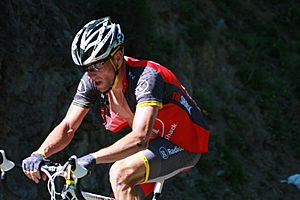
On July 21, 2009, Armstrong announced that he would return to the Tour de France in 2010. RadioShack was named as the main sponsor for Armstrong's 2010 team, named Team RadioShack. Armstrong made his 2010 season debut at the Tour Down Under where he finished 25th out of the 127 riders who completed the race. He made his European season debut at the 2010 Vuelta a Murcia finishing in seventh place overall. Armstrong was also set to compete in several classics such as the Milan–San Remo, Amstel Gold Race, Liège–Bastogne–Liège, and the Tour of Flanders, but bouts with gastroenteritis forced his withdrawal from three of the four races.
Armstrong returned to the United States in mid-April to compete in the Tour of Gila and May's Tour of California, both as preparation for the Tour de France. However, he crashed outside Visalia early in stage 5 of the Tour of California and had to withdraw from the race. He showed fine shape after recovering from the Tour of California crash, placing second in the Tour of Switzerland and third in the Tour of Luxembourg.
On June 28, Armstrong announced via Twitter that the 2010 edition would be his final Tour de France. Armstrong put in an impressive performance in the Tour's prologue time trial, finishing fourth. Only time trial specialists were able to better Armstrong's time and he was the highest placed of the GC contenders with a young, relatively unknown rider, Geraint Thomas, finishing one second behind him and Contador four seconds slower. In all eight of Armstrong's Tours since his comeback in 1999 he always had the requisite good luck early in the Tour and never got involved in crashes or mechanicals, which could cost him serious time. In 2010 his luck ran out early as he lost serious time due to the aftermath and peloton splits caused by a crash on stage 3, and then another crash on stage 8. He rallied for the brutal Pyrenean stage 16, working as a key player in a successful break that included teammate Chris Horner. He finished his last tour in 23rd place, 39 minutes 20 seconds behind former winner Alberto Contador. He was also a key rider in helping Team RadioShack win the team competition, beating Caisse d'Epargne by 9 minutes, 15 seconds. In October, he announced the end of his international career after the Tour Down Under in January 2011. He stated that after January 2011, he will race only in the U.S. with the Radioshack domestic team.
Armstrong announced his retirement from competitive cycling 'for good' on February 16, 2011.
Collaboration of sponsors
Armstrong improved the support behind his well-funded teams, asking sponsors and suppliers to contribute and act as part of the team. For example, rather than having the frame, handlebars, and tires designed and developed by separate companies with little interaction, his teams adopted a Formula One relationship with sponsors and suppliers named "F-One", taking full advantage of the combined resources of several organizations working in close communication. The team, Trek, Nike, AMD, Bontrager (a Trek company), Shimano, Sram, Giro, and Oakley, collaborated for an array of products.
Personal life
Armstrong owns homes in Austin, Texas, and Aspen, Colorado, as well as a ranch in the Texas Hill Country.
Relationships and children
Armstrong met Kristin Richard in June 1997. They married on May 1, 1998, and had three children: a son (born October 1999) and twin daughters (born November 2001). The couple divorced in 2003. At Armstrong's request, his children flew to Paris for the Tour de France podium ceremony in 2005, where his son Luke helped his father hoist the trophy, while his daughters (in yellow dresses) held the stuffed lion mascot and bouquet of yellow flowers.
Lance and Kristin Armstrong announced their divorce in 2003, the same year that Lance began dating singer-songwriter Sheryl Crow. The couple announced their engagement in September 2005 and their split in February 2006.
In July 2008, Armstrong began dating Anna Hansen after meeting through Armstrong's charity work. In December 2008, Armstrong announced that Hansen was pregnant with the couple's first child. They have a son (born June 2009) and a daughter (born October 2010). They were married on August 9, 2022.
Politics
In a New York Times article, teammate George Hincapie hinted that Armstrong would run for Governor of Texas after cycling. In the July 2005 issue of Outside magazine, Armstrong hinted at running for governor, although "not in '06". Armstrong and former president George W. Bush, a Republican and fellow Texan, call themselves friends. Bush called Armstrong in France to congratulate him after his 2005 victory. In August 2005, The Times reported the President had invited Armstrong to his Prairie Chapel Ranch to go mountain biking. In a 2003 interview with The Observer, Armstrong said: "He's a personal friend, but we've all got the right not to agree with our friends."
In August 2005, Armstrong hinted he had changed his mind about politics. In an interview with Charlie Rose on PBS on August 1, 2005, Armstrong pointed out that running for governor would require the commitment that led him to retire from cycling. Also, in August 2005, Armstrong said that he was no longer considering politics:
The biggest problem with politics or running for the governor—the governor's race here in Austin or in Texas—is that it would mimic exactly what I've done: a ton of stress and a ton of time away from my kids. Why would I want to go from pro cycling, which is stressful and a lot of time away, straight into politics?
Armstrong created a YouTube video in 2007 with former President George H. W. Bush to successfully pass Proposition 15, a US$3 billion taxpayer bond initiative which created the Cancer Prevention and Research Institute of Texas.
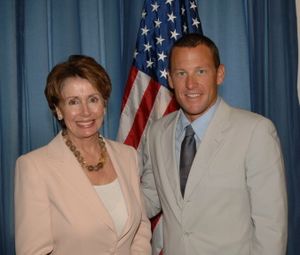
Armstrong was co-chair of a California campaign committee to pass the California Cancer Research Act, a ballot measure defeated by California voters on June 5, 2012. Had it passed, the measure was projected to generate over $500 million annually for cancer research, smoking-cessation programs and tobacco law-enforcement by levying a $1-per-pack tax on tobacco products in California.
Armstrong endorsed Democratic Congressman Beto O'Rourke against Republican incumbent Senator Ted Cruz in the 2018 election.
Outside cycling
In 1997, Armstrong founded the Lance Armstrong Foundation, which supports people affected by cancer. The foundation raises awareness of cancer and has raised more than $325 million from the sale of yellow Livestrong bracelets. During his first retirement beginning after the 2005 season, he also maintained other interests. He was the pace car driver of the Chevrolet Corvette Z06 for the 2006 Indianapolis 500. In 2007, Armstrong with Andre Agassi, Muhammad Ali, Warrick Dunn, Jeff Gordon, Mia Hamm, Tony Hawk, Andrea Jaeger, Jackie Joyner-Kersee, Mario Lemieux, Alonzo Mourning, and Cal Ripken Jr. founded Athletes for Hope, a charity that helps professional athletes become involved in charitable causes and aims to inspire non-athletes to volunteer and support the community.
In August 2009, Armstrong headlined the inaugural charity ride "Pelotonia" in Columbus, Ohio, riding over 100 miles on Saturday with the large group of cyclists. He addressed the riders the Friday evening before the two-day ride and helped the ride raise millions for cancer research. Armstrong ran the 2006 New York City Marathon with two friends. He assembled a pace team of Alberto Salazar, Joan Benoit Samuelson, and Hicham El Guerrouj to help him reach three hours. He finished in 2h 59m 36s, in 856th place. He said the race was extremely difficult compared to the Tour de France. The NYC Marathon had a dedicated camera on Armstrong throughout the event which, according to Armstrong, pushed him to continue through points in which he would have normally "stopped and stretched". He also helped raise $600,000 for his LiveStrong campaign during the run. Armstrong ran the 2007 NYC Marathon in 2h 46m 43s, finishing 232nd. On April 21, 2008, he ran the Boston Marathon in 2h 50m 58s, finishing in the top 500.
Armstrong made a return to triathlon in 2011 by competing in the off-road XTERRA Triathlon race series. At the Championships Armstrong led for a time before crashing out on the bike and finishing in 23rd place. The following year, in 2012, Armstrong began pursuing qualification into the 2012 Ironman World Championship. He was scheduled to next participate in Ironman France on June 24. However, the June suspension by USADA and eventual ban by WADA prohibited Armstrong from further racing Ironman branded events.
In July 2011 and July 2013, Armstrong participated in the non-competitive Register's Annual Great Bicycle Ride Across Iowa.
Business and investments
Armstrong owns a coffee shop in downtown Austin, Texas, called "Juan Pelota Cafe". In the same building, Armstrong owns and operates a bike shop named "Mellow Johnny's", after another nickname of his derived from the Tour term "maillot jaune", which is French for yellow jersey, the jersey given to the leader of the general classification.
In 2001, Armstrong provided funding to launch Wonders & Worries, a non-profit organization in Austin, Texas that provides counseling and support for children who have a parent with a serious or life-threatening disease.
A line of cycling clothing from Nike, 10//2, was named after the date (October 2, 1996) that Armstrong was diagnosed with testicular cancer.
In 2008, Armstrong bought several million dollars of stock in the American bicycle component manufacturer SRAM Corporation, and has served as their technical advisor. SRAM bought those shares back from him in preparation for a public offering. Armstrong owns a small share of Trek Bicycle Corporation.
In 2009, Armstrong invested $100,000 into venture capital firm Lowercase Capital, which subsequently bought an early stake in Uber, among other investments. In 2019, Uber achieved an IPO of $82 billion and earned Armstrong an estimated $20–$30 million. According to CNBC, Armstrong said "it saved our family".
Media
In 2017, Armstrong started a podcast named "The Move", which provided daily coverage of the Tour de France in 2018 and 2019. He also appeared—without compensation—on NBC Sports Network's live Tour de France television broadcasts. The UCI indicated the podcast and NBC appearances did not violate the terms of his ban.
Career achievements
Major results
Road
- 1990
- 8th Overall Tour of Sweden
- 1991
- 1st
Road race, National Junior Road Championships
- 1992
- 1st
 Overall Fitchburg Longsjo Classic
Overall Fitchburg Longsjo Classic
- 1st Stage 2
- 1st First Union Grand Prix
- 1st Stage 6 Settimana Bergamasca
- 1st Stage 4a Vuelta a Galicia
- 1st Stage 2 Trittico Premondiale
- 2nd Züri-Metzgete
- 8th Coppa Bernocchi
- 1993
- 1st
 Road race, UCI Road World Championships
Road race, UCI Road World Championships - 1st
Road race, National Road Championships
- 1st
 Overall Kmart West Virginia Classic
Overall Kmart West Virginia Classic
- 1st Prologue & Stage 1
- 1st
 Overall Tour of America
Overall Tour of America - 1st Trofeo Laigueglia
- 1st Thrift Drug Classic
- 1st Stage 8 Tour de France
- 2nd Overall Tour DuPont
- 1st Stage 5
- 3rd Overall Tour of Sweden
- 1st Stage 3
- 5th Wincanton Classic
- 9th Overall Paris–Nice
- 1994
- 1st Thrift Drug Classic
- 2nd Overall Tour DuPont
- 1st Stage 7
- 2nd Liège–Bastogne–Liège
- 2nd Clásica de San Sebastián
- 7th Overall Tour de Suisse
- 7th Road race, UCI Road World Championships
- 9th Trofeo Laigueglia
- 9th Züri-Metzgete
- 1995
- 1st
 Overall Tour DuPont
Overall Tour DuPont
- 1st
 Overall Kmart West Virginia Classic
Overall Kmart West Virginia Classic
- 1st Stage 4
- 1st Clásica de San Sebastián
- 1st Stage 18 Tour de France
- 1st Stage 5 Paris–Nice
- 5th Road race, National Road Championships
- 6th Liège–Bastogne–Liège
- 10th Overall Vuelta a Burgos
- 10th Züri-Metzgete
- 1996
- 1st
 Overall Tour DuPont
Overall Tour DuPont
- 1st Stages 2, 3b (ITT), 5, 6 & 12 (ITT)
- 1st La Flèche Wallonne
- 2nd Overall Paris–Nice
- 2nd Overall Ronde van Nederland
- 2nd Liège–Bastogne–Liège
- 2nd Grand Prix Eddy Merckx
- 4th Overall Tour de Suisse
- 4th Wincanton Classic
- 6th Time trial, Olympic Games
- 8th E3 Prijs Vlaanderen
- 9th LuK Challenge Chrono (with Sean Yates
- 1998
- 1st
 Overall Tour de Luxembourg
Overall Tour de Luxembourg
- 1st Stage 1
- 1st
 Overall Rheinland-Pfalz Rundfahrt
Overall Rheinland-Pfalz Rundfahrt - 1st Cascade Cycling Classic
- 1st Sprint 56K Criterium
- 4th Overall Ronde van Nederland
4th Overall Vuelta a España4th Road race, UCI Road World Road Championships- 1999
1st Overall Tour de France
Overall Tour de France1st Prologue, Stages 8 (ITT), 9 & 19 (ITT)
1st Stage 4 Route du Sud1st Stage 4 (ITT) Circuit de la Sarthe1st RaboRonde Heerlen2nd Amstel Gold Race7th Overall Vuelta a Aragón8th Overall Critérium du Dauphiné Libéré1st Prologue
- 2000
1st Overall Tour de France
Overall Tour de France1st Stage 19 (ITT)
1st Grand Prix des Nations1st Grand Prix Eddy Merckx2nd Paris–Camembert3rd Overall Critérium du Dauphiné Libéré1st Stage 3 (ITT)
3rd Time trial, Olympic Games
Time trial, Olympic Games3rd Classique des Alpes4th Grand Prix Gippingen5th Züri-Metzgete7th GP Miguel Induráin- 2001
1st Overall Tour de France
Overall Tour de France1st Stages 10, 11 (ITT), 13 & 18 (ITT)
1st Overall Tour de Suisse
Overall Tour de Suisse1st Stages 1 (ITT) & 8 (ITT)
2nd Amstel Gold Race2nd Classique des Alpes- 2002
1st Overall Tour de France
Overall Tour de France1st Prologue, Stages 11, 12 & 19 (ITT)
1st Overall Critérium du Dauphiné Libéré
Overall Critérium du Dauphiné Libéré1st Stage 6
1st Overall Grand Prix du Midi Libre
Overall Grand Prix du Midi Libre1st Profronde van Stiphout2nd Overall Critérium International3rd Züri-Metzgete4th Amstel Gold Race5th Grand Prix Eddy Merckx6th San Francisco Grand Prix8th LuK Challenge Chrono (with Floyd Landis)- 2003
1st Overall Tour de France
Overall Tour de France1st Stages 4 (TTT) & 15
1st Overall Critérium du Dauphiné Libéré
Overall Critérium du Dauphiné Libéré1st Stage 3 (ITT)
6th LuK Challenge Chrono (with Viatcheslav Ekimov)8th Amstel Gold Race- 2004
1st Overall Tour de France
Overall Tour de France1st Stages 4 (TTT), 13, 15, 16 (ITT), 17 & 19 (ITT)
1st Overall Tour de Georgia
Overall Tour de Georgia1st Stages 3 & 4 (ITT)
1st Profronde van Stiphout3rd Overall Critérium International4th LuK Challenge Chrono (with George Hincapie)5th Overall Volta ao Algarve1st Stage 4 (ITT)
6th Overall Tour du Languedoc-Roussillon1st Stage 5
- 2005
1st Overall Tour de France
Overall Tour de France1st Stages 4 (TTT) & 20 (ITT)
4th Overall Critérium du Dauphiné Libéré5th Overall Tour de Georgia- 2009
1st Nevada City Classic2nd Overall Tour of the Gila3rd Overall Tour de France1st Stage 4 (TTT)
7th Overall Tour of California- 2010
2nd Overall Tour de Suisse3rd Overall Tour de Luxembourg7th Overall Vuelta a Murcia
Grand Tour general classification results timeline
| Grand Tour | 1993 | 1994 | 1995 | 1996 | 1998 | 1999 | 2000 | 2001 | 2002 | 2003 | 2004 | 2005 | 2006 | 2007 | 2008 | 2009 | 2010 |
|---|---|---|---|---|---|---|---|---|---|---|---|---|---|---|---|---|---|
| — | — | — | — | — | — | — | — | — | — | — | — | — | — | — | — | ||
| DNF | DNF | 36 | DNF | — | — | — | — | ||||||||||
| — | — | — | — | — | — | — | — | — | — | — | — | — | — | — | — |
| — | Did not compete |
|---|---|
| DNF | Did not finish |
| Voided result |
Triathlon & Ironman
- 1989
- 2nd Bud Light U.S. Triathlon Series (USTS)–Miami (Olympic Distance)
- 1st National Sprint Course Triathlon
- 1990
- 1st National Sprint Course Triathlon
- 2011
- 5th XTERRA USA Championships
- 2012
- 1st Ironman 70.3 Hawaii
- 1st Ironman 70.3 Florida
- 3rd Ironman 70.3 St. Croix
- 7th Ironman 70.3 Texas
- 2nd Ironman 70.3 Panama
- 2nd Power of Four Mountain Bike Race
Mountain Bike
- 2008
1st 12 Hours of Snowmass2nd Leadville Trail 100 Mountain Bike Race- 2009
1st Colorado Pro Cross-Country Championships1st Leadville Trail 100 Mountain Bike Race
Filmography
- Road to Paris (2001), documentary
- DodgeBall: A True Underdog Story (2004), cameo appearance
- You, Me and Dupree (2006), cameo appearance
- The Armstrong Lie (2013), documentary
- Stop at Nothing: The Lance Armstrong Story (2014), documentary
- The Program (2015), biographical drama film
- Tour de Pharmacy (2017), appearing as himself, acting as parody of an anonymous source
- Lance (2020), documentary
Accolades
- United States Olympic Committee (USOC) SportsMan of the Year (1999, 2001, 2002, 2003)
- Associated Press Male Athlete of the Year (2002, 2003, 2004, 2005)
- World's Most Outstanding Athlete Award, Jesse Owens International Trophy (2000)
- Reuters Sportsman of the Year (2003)
- Prince of Asturias Award in Sports (2000)
- Sports Ethics Fellows by the Institute for International Sport (2003)
- Mendrisio d'Or Award in Switzerland (1999)
- Premio Coppi-Bici d'Oro Trophy by the Fausto Coppi foundation in conjunction with La Gazzetta dello Sport (1999, 2000)
- Marca Legend Award by Marca, a Spanish sports daily in Madrid (2004)
- ESPY Award for Best Male Athlete (2003, 2004, 2005, 2006)
- ESPY Award for GMC Professional Grade Play Award (2005)
- ESPY Award for Best Comeback Athlete (2000)
- ESPN/Intersport's ARETE Award for Courage in Sport (Professional Division) (1999)
- ABC's Wide World of Sports Athlete of the Year (1999)
- Favorite Athlete award at Nickelodeon Kids' Choice Awards (2006)
- Presidential Delegation to the XIX Olympic Winter Games (2002)
- Sports Illustrated magazine's Sportsman of the Year (2002)
- VeloNews magazine's International Cyclist of the Year (2000, 2001, 2003, 2004)
- VeloNews magazine's North American Male Cyclist of the Year (1993, 1995, 1996, 1998, 1999, 2002, 2005)
- William Hill Sports Book of the Year: It's Not About the Bike: My Journey Back to Life (2000)
- Triathlon magazine's Rookie of the Year (1988)
- Pace car driver for the Indianapolis 500 (2006)
- An asteroid, 1994 JE9 was named 12373 Lancearmstrong in honor of him.
- Six-mile Lance Armstrong Bikeway through downtown Austin, Texas, built by the city of Austin at a cost of $3.2 million.
- Mildred "Babe" Didrikson Zaharias Courage Award presented by the United States Sports Academy (1999)
- Samuel S. Beard Award for Greatest Public Service by an Individual 35 Years or Under, an award given out annually by Jefferson Awards (2001)
Rescinded awards
- BBC Overseas Sports Personality of the Year Award (2003)
- Honorary Doctorate of Humane Letters, Tufts University (2006)
- Key to the city of Adelaide (2012)
- Laureus World Sports Award for Sportsman of the Year Winner (2003)
- Laureus World Sports Award for Comeback of the Year Winner (2000)
- Laureus World Sports Award for Sportsman of the Year Nominated (2002, 2004, 2005, 2006)
- Laureus World Sports Award for Comeback of the Year Nominated (2010)
- Grand Prix Serge-Kampf de l'Académie des sports (France, 2004)
- Légion d'honneur (France, 2005)
- Vélo d'Or Award by Velo magazine in France (1999, 2000, 2001, 2003, 2004)
See also
 In Spanish: Lance Armstrong para niños
In Spanish: Lance Armstrong para niños
- Cycling records


